Analysis of Tort Law in Business: Importance, Types, and Remedies
VerifiedAdded on 2022/09/17
|9
|2267
|15
Report
AI Summary
This report provides a comprehensive overview of tort law within the context of business operations. It begins with a definition of tort law as a civil wrong causing loss or injury, leading to legal liabilities, and emphasizes its overlap with other areas of law. The report delves into the purpose of tort law, which is to restore injured parties and deter wrongful actions. It then explores business torts, which are intentional interferences with business interests resulting in financial losses, including examples such as fraudulent misrepresentation, tortious interference, theft of trade secrets, unfair competition, and disparagement. The report also discusses remedies for business torts, including monetary damages and injunctions, and touches upon personal and vicarious liability, along with the limitation period for bringing a tort action. The conclusion reiterates the importance of tort law in protecting businesses from unlawful conduct and financial losses.
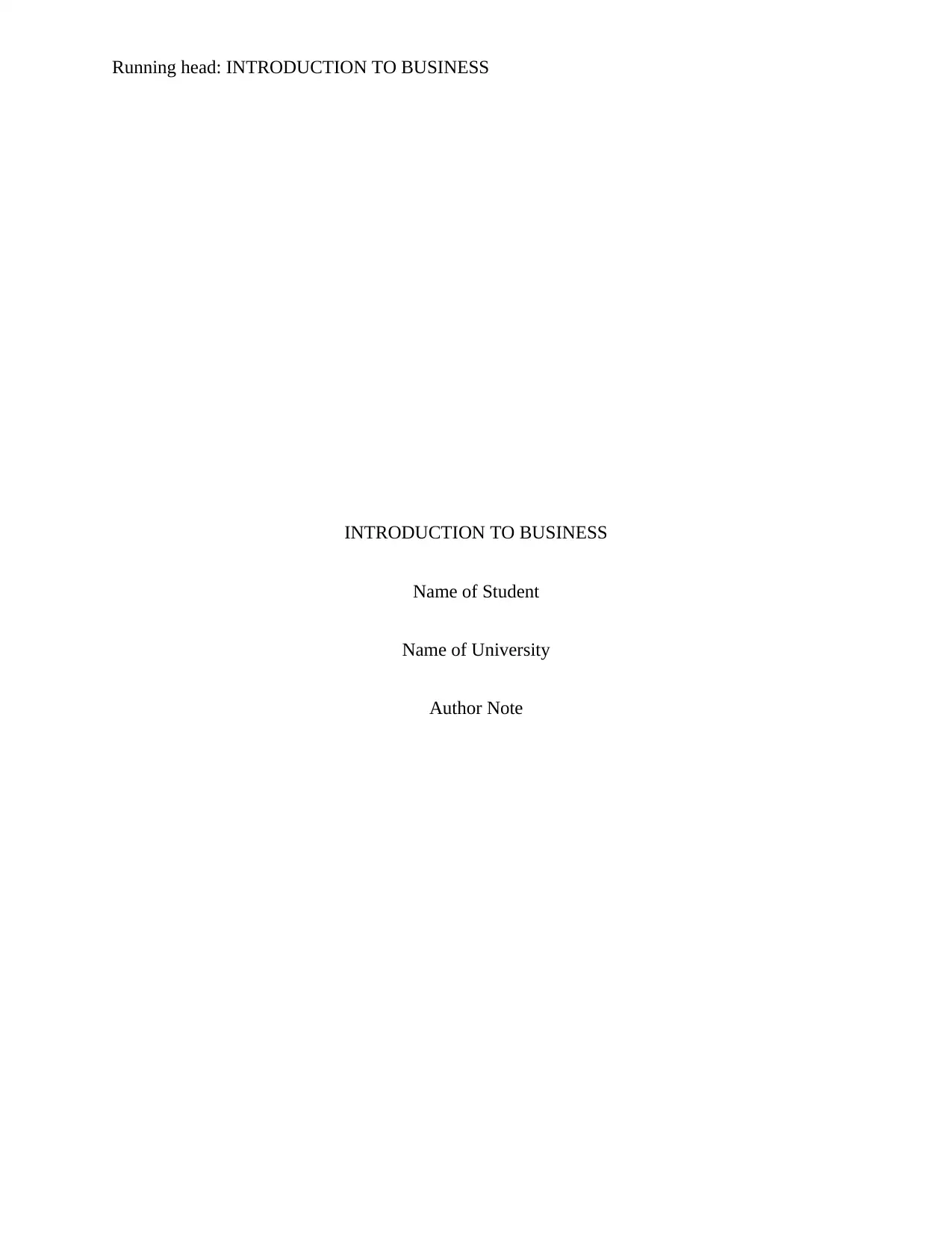
Running head: INTRODUCTION TO BUSINESS
INTRODUCTION TO BUSINESS
Name of Student
Name of University
Author Note
INTRODUCTION TO BUSINESS
Name of Student
Name of University
Author Note
Paraphrase This Document
Need a fresh take? Get an instant paraphrase of this document with our AI Paraphraser
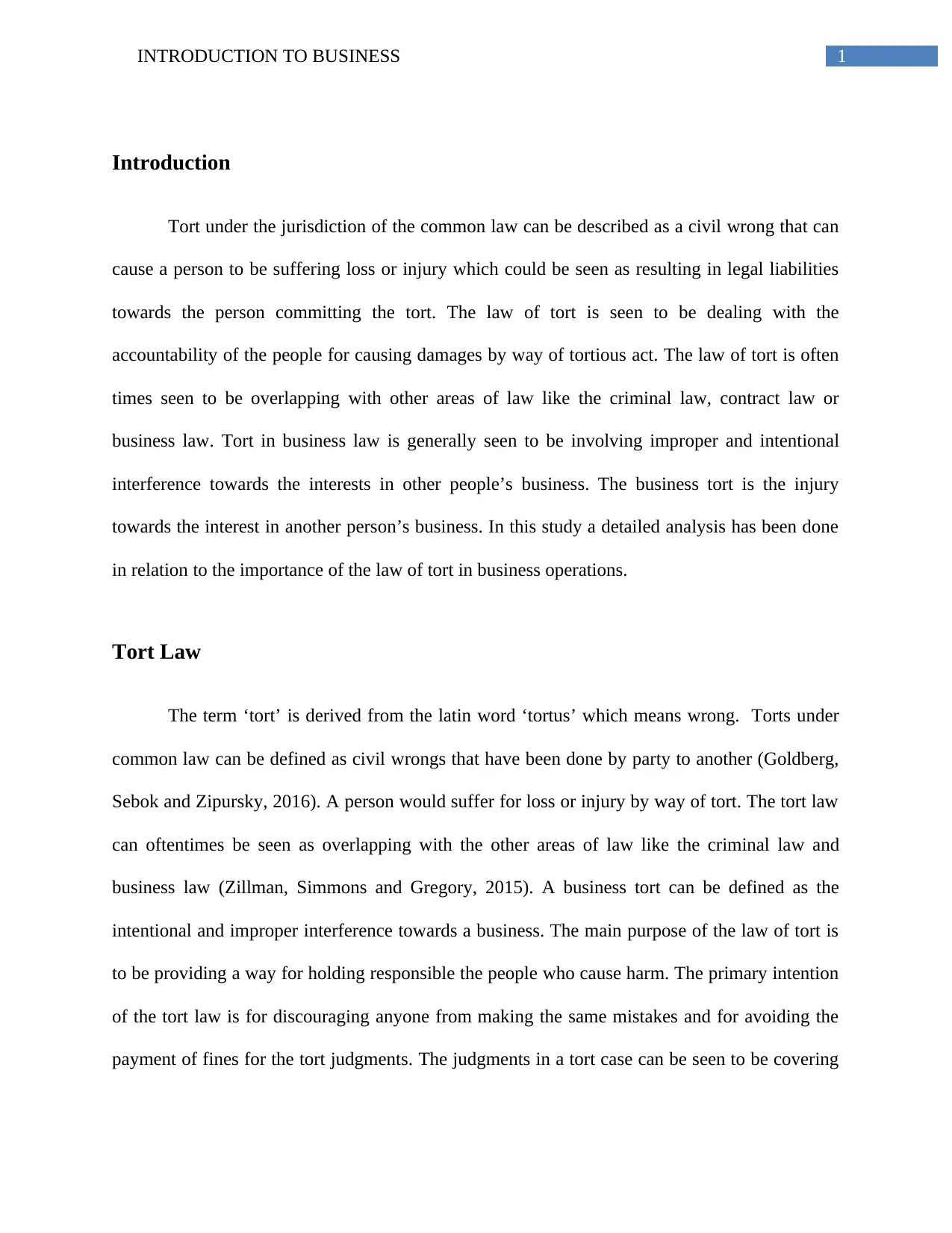
1INTRODUCTION TO BUSINESS
Introduction
Tort under the jurisdiction of the common law can be described as a civil wrong that can
cause a person to be suffering loss or injury which could be seen as resulting in legal liabilities
towards the person committing the tort. The law of tort is seen to be dealing with the
accountability of the people for causing damages by way of tortious act. The law of tort is often
times seen to be overlapping with other areas of law like the criminal law, contract law or
business law. Tort in business law is generally seen to be involving improper and intentional
interference towards the interests in other people’s business. The business tort is the injury
towards the interest in another person’s business. In this study a detailed analysis has been done
in relation to the importance of the law of tort in business operations.
Tort Law
The term ‘tort’ is derived from the latin word ‘tortus’ which means wrong. Torts under
common law can be defined as civil wrongs that have been done by party to another (Goldberg,
Sebok and Zipursky, 2016). A person would suffer for loss or injury by way of tort. The tort law
can oftentimes be seen as overlapping with the other areas of law like the criminal law and
business law (Zillman, Simmons and Gregory, 2015). A business tort can be defined as the
intentional and improper interference towards a business. The main purpose of the law of tort is
to be providing a way for holding responsible the people who cause harm. The primary intention
of the tort law is for discouraging anyone from making the same mistakes and for avoiding the
payment of fines for the tort judgments. The judgments in a tort case can be seen to be covering
Introduction
Tort under the jurisdiction of the common law can be described as a civil wrong that can
cause a person to be suffering loss or injury which could be seen as resulting in legal liabilities
towards the person committing the tort. The law of tort is seen to be dealing with the
accountability of the people for causing damages by way of tortious act. The law of tort is often
times seen to be overlapping with other areas of law like the criminal law, contract law or
business law. Tort in business law is generally seen to be involving improper and intentional
interference towards the interests in other people’s business. The business tort is the injury
towards the interest in another person’s business. In this study a detailed analysis has been done
in relation to the importance of the law of tort in business operations.
Tort Law
The term ‘tort’ is derived from the latin word ‘tortus’ which means wrong. Torts under
common law can be defined as civil wrongs that have been done by party to another (Goldberg,
Sebok and Zipursky, 2016). A person would suffer for loss or injury by way of tort. The tort law
can oftentimes be seen as overlapping with the other areas of law like the criminal law and
business law (Zillman, Simmons and Gregory, 2015). A business tort can be defined as the
intentional and improper interference towards a business. The main purpose of the law of tort is
to be providing a way for holding responsible the people who cause harm. The primary intention
of the tort law is for discouraging anyone from making the same mistakes and for avoiding the
payment of fines for the tort judgments. The judgments in a tort case can be seen to be covering
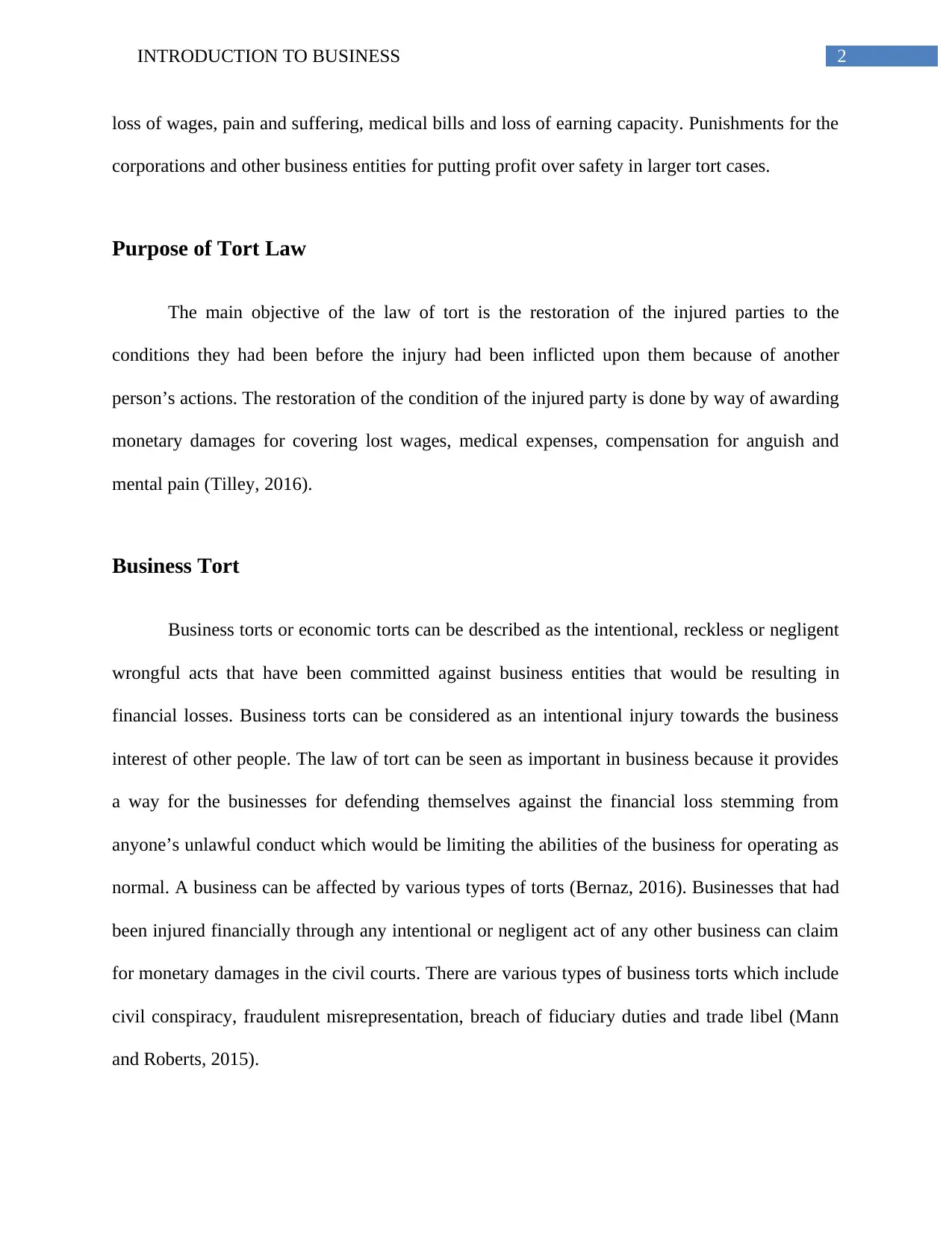
2INTRODUCTION TO BUSINESS
loss of wages, pain and suffering, medical bills and loss of earning capacity. Punishments for the
corporations and other business entities for putting profit over safety in larger tort cases.
Purpose of Tort Law
The main objective of the law of tort is the restoration of the injured parties to the
conditions they had been before the injury had been inflicted upon them because of another
person’s actions. The restoration of the condition of the injured party is done by way of awarding
monetary damages for covering lost wages, medical expenses, compensation for anguish and
mental pain (Tilley, 2016).
Business Tort
Business torts or economic torts can be described as the intentional, reckless or negligent
wrongful acts that have been committed against business entities that would be resulting in
financial losses. Business torts can be considered as an intentional injury towards the business
interest of other people. The law of tort can be seen as important in business because it provides
a way for the businesses for defending themselves against the financial loss stemming from
anyone’s unlawful conduct which would be limiting the abilities of the business for operating as
normal. A business can be affected by various types of torts (Bernaz, 2016). Businesses that had
been injured financially through any intentional or negligent act of any other business can claim
for monetary damages in the civil courts. There are various types of business torts which include
civil conspiracy, fraudulent misrepresentation, breach of fiduciary duties and trade libel (Mann
and Roberts, 2015).
loss of wages, pain and suffering, medical bills and loss of earning capacity. Punishments for the
corporations and other business entities for putting profit over safety in larger tort cases.
Purpose of Tort Law
The main objective of the law of tort is the restoration of the injured parties to the
conditions they had been before the injury had been inflicted upon them because of another
person’s actions. The restoration of the condition of the injured party is done by way of awarding
monetary damages for covering lost wages, medical expenses, compensation for anguish and
mental pain (Tilley, 2016).
Business Tort
Business torts or economic torts can be described as the intentional, reckless or negligent
wrongful acts that have been committed against business entities that would be resulting in
financial losses. Business torts can be considered as an intentional injury towards the business
interest of other people. The law of tort can be seen as important in business because it provides
a way for the businesses for defending themselves against the financial loss stemming from
anyone’s unlawful conduct which would be limiting the abilities of the business for operating as
normal. A business can be affected by various types of torts (Bernaz, 2016). Businesses that had
been injured financially through any intentional or negligent act of any other business can claim
for monetary damages in the civil courts. There are various types of business torts which include
civil conspiracy, fraudulent misrepresentation, breach of fiduciary duties and trade libel (Mann
and Roberts, 2015).
⊘ This is a preview!⊘
Do you want full access?
Subscribe today to unlock all pages.

Trusted by 1+ million students worldwide
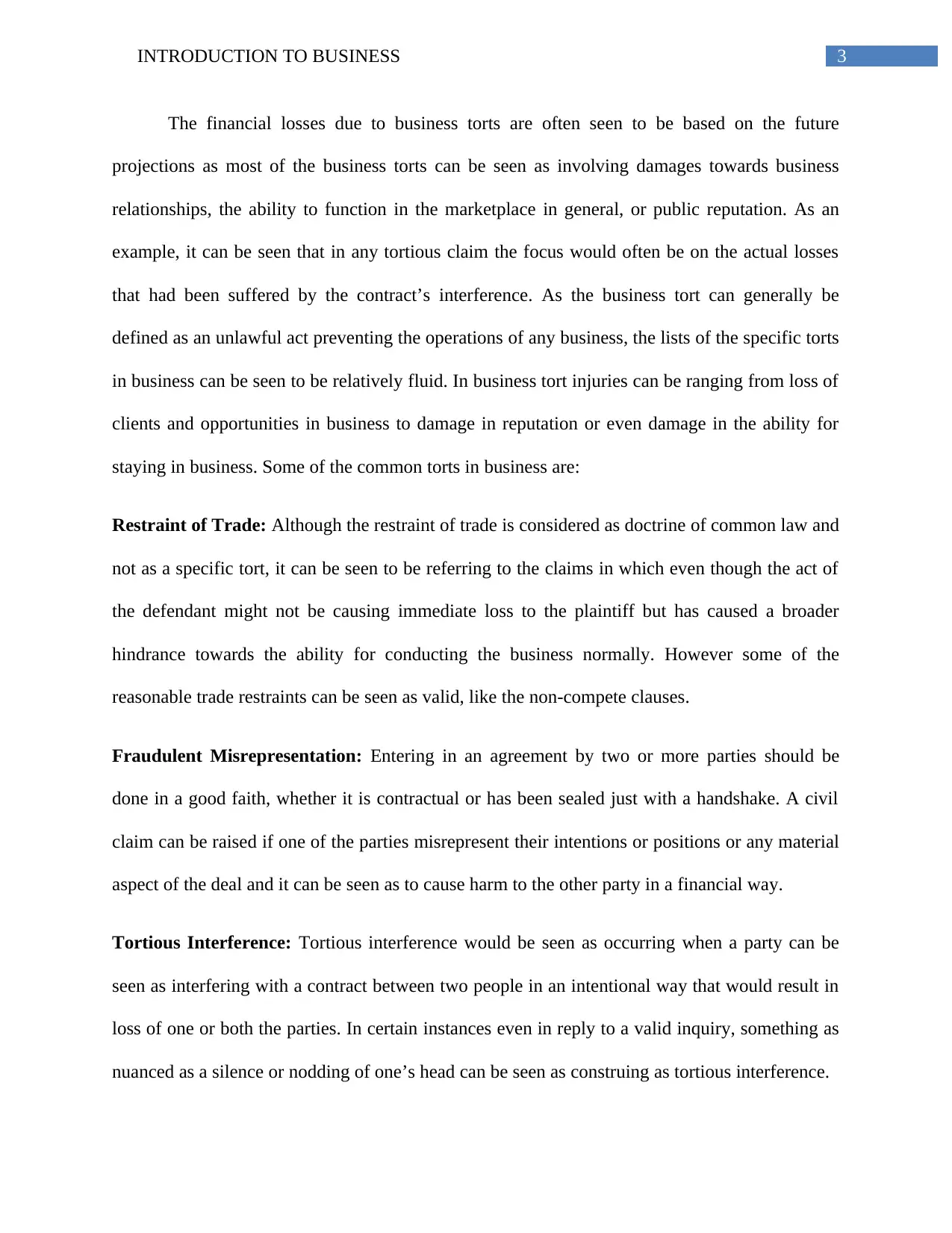
3INTRODUCTION TO BUSINESS
The financial losses due to business torts are often seen to be based on the future
projections as most of the business torts can be seen as involving damages towards business
relationships, the ability to function in the marketplace in general, or public reputation. As an
example, it can be seen that in any tortious claim the focus would often be on the actual losses
that had been suffered by the contract’s interference. As the business tort can generally be
defined as an unlawful act preventing the operations of any business, the lists of the specific torts
in business can be seen to be relatively fluid. In business tort injuries can be ranging from loss of
clients and opportunities in business to damage in reputation or even damage in the ability for
staying in business. Some of the common torts in business are:
Restraint of Trade: Although the restraint of trade is considered as doctrine of common law and
not as a specific tort, it can be seen to be referring to the claims in which even though the act of
the defendant might not be causing immediate loss to the plaintiff but has caused a broader
hindrance towards the ability for conducting the business normally. However some of the
reasonable trade restraints can be seen as valid, like the non-compete clauses.
Fraudulent Misrepresentation: Entering in an agreement by two or more parties should be
done in a good faith, whether it is contractual or has been sealed just with a handshake. A civil
claim can be raised if one of the parties misrepresent their intentions or positions or any material
aspect of the deal and it can be seen as to cause harm to the other party in a financial way.
Tortious Interference: Tortious interference would be seen as occurring when a party can be
seen as interfering with a contract between two people in an intentional way that would result in
loss of one or both the parties. In certain instances even in reply to a valid inquiry, something as
nuanced as a silence or nodding of one’s head can be seen as construing as tortious interference.
The financial losses due to business torts are often seen to be based on the future
projections as most of the business torts can be seen as involving damages towards business
relationships, the ability to function in the marketplace in general, or public reputation. As an
example, it can be seen that in any tortious claim the focus would often be on the actual losses
that had been suffered by the contract’s interference. As the business tort can generally be
defined as an unlawful act preventing the operations of any business, the lists of the specific torts
in business can be seen to be relatively fluid. In business tort injuries can be ranging from loss of
clients and opportunities in business to damage in reputation or even damage in the ability for
staying in business. Some of the common torts in business are:
Restraint of Trade: Although the restraint of trade is considered as doctrine of common law and
not as a specific tort, it can be seen to be referring to the claims in which even though the act of
the defendant might not be causing immediate loss to the plaintiff but has caused a broader
hindrance towards the ability for conducting the business normally. However some of the
reasonable trade restraints can be seen as valid, like the non-compete clauses.
Fraudulent Misrepresentation: Entering in an agreement by two or more parties should be
done in a good faith, whether it is contractual or has been sealed just with a handshake. A civil
claim can be raised if one of the parties misrepresent their intentions or positions or any material
aspect of the deal and it can be seen as to cause harm to the other party in a financial way.
Tortious Interference: Tortious interference would be seen as occurring when a party can be
seen as interfering with a contract between two people in an intentional way that would result in
loss of one or both the parties. In certain instances even in reply to a valid inquiry, something as
nuanced as a silence or nodding of one’s head can be seen as construing as tortious interference.
Paraphrase This Document
Need a fresh take? Get an instant paraphrase of this document with our AI Paraphraser
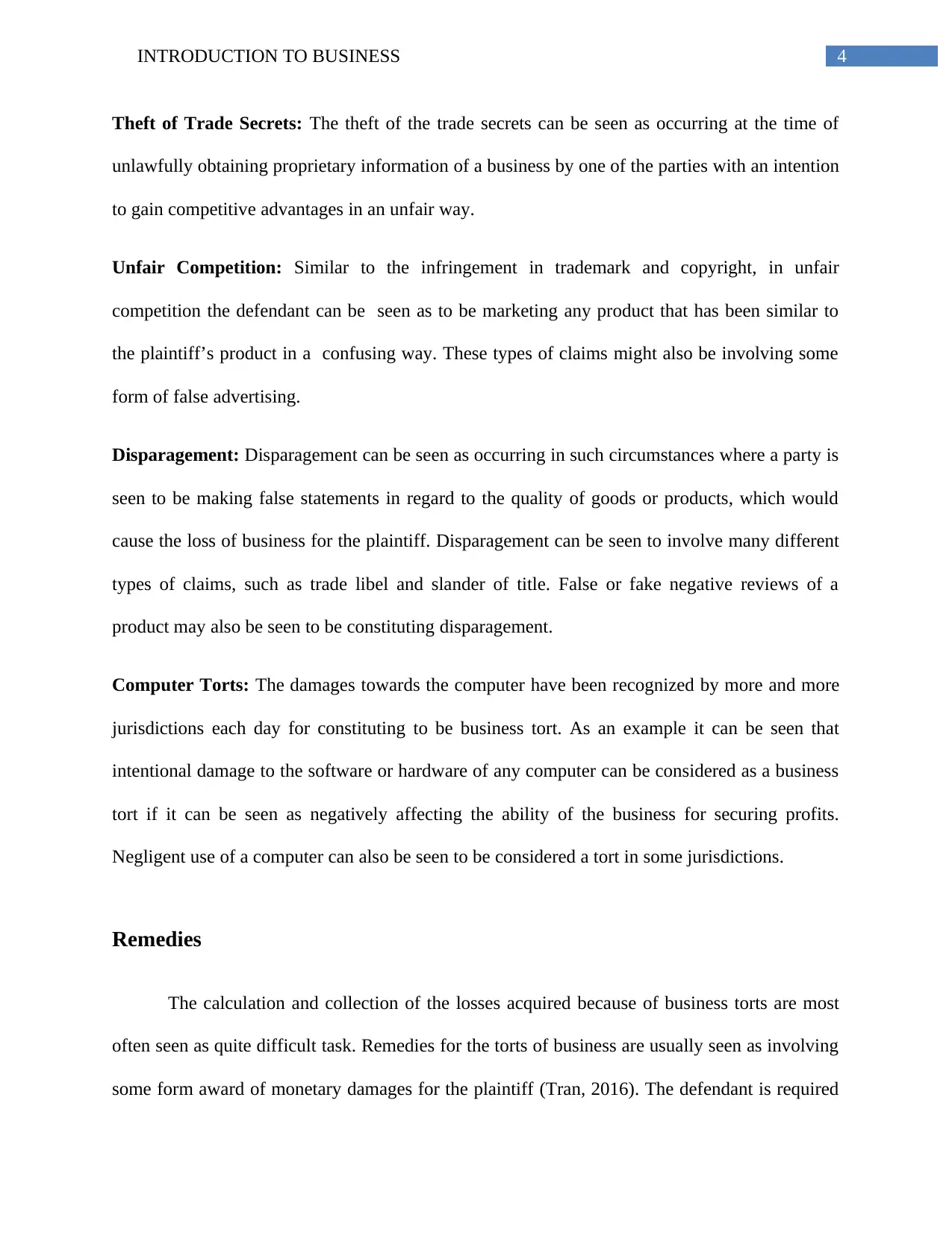
4INTRODUCTION TO BUSINESS
Theft of Trade Secrets: The theft of the trade secrets can be seen as occurring at the time of
unlawfully obtaining proprietary information of a business by one of the parties with an intention
to gain competitive advantages in an unfair way.
Unfair Competition: Similar to the infringement in trademark and copyright, in unfair
competition the defendant can be seen as to be marketing any product that has been similar to
the plaintiff’s product in a confusing way. These types of claims might also be involving some
form of false advertising.
Disparagement: Disparagement can be seen as occurring in such circumstances where a party is
seen to be making false statements in regard to the quality of goods or products, which would
cause the loss of business for the plaintiff. Disparagement can be seen to involve many different
types of claims, such as trade libel and slander of title. False or fake negative reviews of a
product may also be seen to be constituting disparagement.
Computer Torts: The damages towards the computer have been recognized by more and more
jurisdictions each day for constituting to be business tort. As an example it can be seen that
intentional damage to the software or hardware of any computer can be considered as a business
tort if it can be seen as negatively affecting the ability of the business for securing profits.
Negligent use of a computer can also be seen to be considered a tort in some jurisdictions.
Remedies
The calculation and collection of the losses acquired because of business torts are most
often seen as quite difficult task. Remedies for the torts of business are usually seen as involving
some form award of monetary damages for the plaintiff (Tran, 2016). The defendant is required
Theft of Trade Secrets: The theft of the trade secrets can be seen as occurring at the time of
unlawfully obtaining proprietary information of a business by one of the parties with an intention
to gain competitive advantages in an unfair way.
Unfair Competition: Similar to the infringement in trademark and copyright, in unfair
competition the defendant can be seen as to be marketing any product that has been similar to
the plaintiff’s product in a confusing way. These types of claims might also be involving some
form of false advertising.
Disparagement: Disparagement can be seen as occurring in such circumstances where a party is
seen to be making false statements in regard to the quality of goods or products, which would
cause the loss of business for the plaintiff. Disparagement can be seen to involve many different
types of claims, such as trade libel and slander of title. False or fake negative reviews of a
product may also be seen to be constituting disparagement.
Computer Torts: The damages towards the computer have been recognized by more and more
jurisdictions each day for constituting to be business tort. As an example it can be seen that
intentional damage to the software or hardware of any computer can be considered as a business
tort if it can be seen as negatively affecting the ability of the business for securing profits.
Negligent use of a computer can also be seen to be considered a tort in some jurisdictions.
Remedies
The calculation and collection of the losses acquired because of business torts are most
often seen as quite difficult task. Remedies for the torts of business are usually seen as involving
some form award of monetary damages for the plaintiff (Tran, 2016). The defendant is required
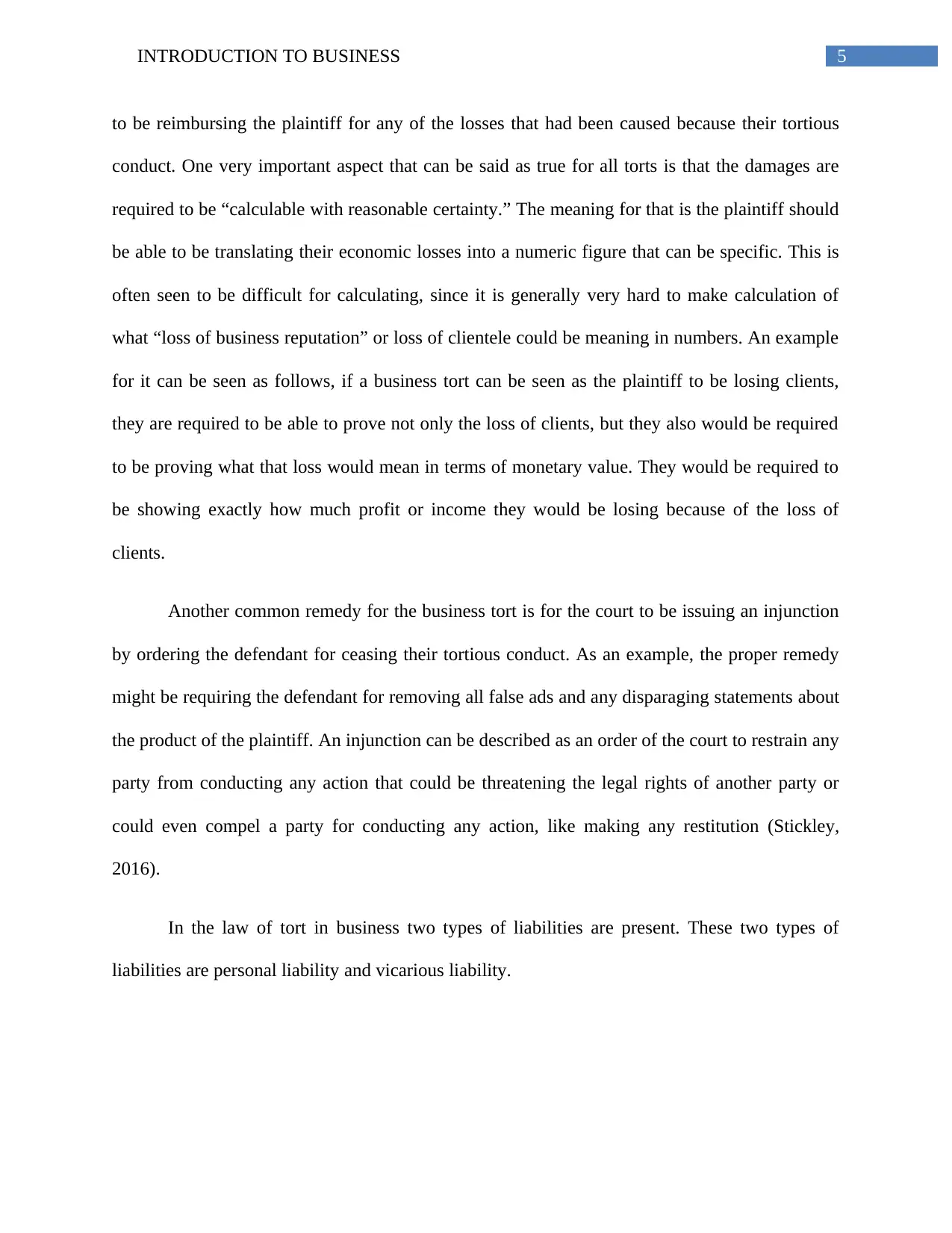
5INTRODUCTION TO BUSINESS
to be reimbursing the plaintiff for any of the losses that had been caused because their tortious
conduct. One very important aspect that can be said as true for all torts is that the damages are
required to be “calculable with reasonable certainty.” The meaning for that is the plaintiff should
be able to be translating their economic losses into a numeric figure that can be specific. This is
often seen to be difficult for calculating, since it is generally very hard to make calculation of
what “loss of business reputation” or loss of clientele could be meaning in numbers. An example
for it can be seen as follows, if a business tort can be seen as the plaintiff to be losing clients,
they are required to be able to prove not only the loss of clients, but they also would be required
to be proving what that loss would mean in terms of monetary value. They would be required to
be showing exactly how much profit or income they would be losing because of the loss of
clients.
Another common remedy for the business tort is for the court to be issuing an injunction
by ordering the defendant for ceasing their tortious conduct. As an example, the proper remedy
might be requiring the defendant for removing all false ads and any disparaging statements about
the product of the plaintiff. An injunction can be described as an order of the court to restrain any
party from conducting any action that could be threatening the legal rights of another party or
could even compel a party for conducting any action, like making any restitution (Stickley,
2016).
In the law of tort in business two types of liabilities are present. These two types of
liabilities are personal liability and vicarious liability.
to be reimbursing the plaintiff for any of the losses that had been caused because their tortious
conduct. One very important aspect that can be said as true for all torts is that the damages are
required to be “calculable with reasonable certainty.” The meaning for that is the plaintiff should
be able to be translating their economic losses into a numeric figure that can be specific. This is
often seen to be difficult for calculating, since it is generally very hard to make calculation of
what “loss of business reputation” or loss of clientele could be meaning in numbers. An example
for it can be seen as follows, if a business tort can be seen as the plaintiff to be losing clients,
they are required to be able to prove not only the loss of clients, but they also would be required
to be proving what that loss would mean in terms of monetary value. They would be required to
be showing exactly how much profit or income they would be losing because of the loss of
clients.
Another common remedy for the business tort is for the court to be issuing an injunction
by ordering the defendant for ceasing their tortious conduct. As an example, the proper remedy
might be requiring the defendant for removing all false ads and any disparaging statements about
the product of the plaintiff. An injunction can be described as an order of the court to restrain any
party from conducting any action that could be threatening the legal rights of another party or
could even compel a party for conducting any action, like making any restitution (Stickley,
2016).
In the law of tort in business two types of liabilities are present. These two types of
liabilities are personal liability and vicarious liability.
⊘ This is a preview!⊘
Do you want full access?
Subscribe today to unlock all pages.

Trusted by 1+ million students worldwide

6INTRODUCTION TO BUSINESS
Personal Liability: In case of law of tort of business it can be seen that an employer has the duty
to be taking reasonable care for ensuring the safety of their employees. The duty can be seen as
non delegable and personal.
Vicarious Liability: Vicarious liability can be described as the liability of an employer for an
act or omission by their employees during the ‘scope and course’ of their employment. Principals
can also be held to be vicariously liable for any acts or omissions of their agents (Bell, 2013).
For the determination of whether an employer or a principal could be held vicariously
liable for any tort, the courts would be considering the degree of control the employer or
principal was seen to be having over the individual, and whether the individual could be
considered as ‘part and parcel of the organization’ that is being run by the employer and if there
had been a sufficient relationship between the individual and the employer for the individual to
be considered as an employee.
Limitation Period: The limitation period to be bringing an action in tort law can be seen as six
years from the date in which the cause of action was seen to be arising.
Conclusion
In this study a detailed analysis has been done about the law of tort in business.
Discussions have been made about the purpose of tort, various types of torts conducted in the
business and the remedies that are available. Tort under the jurisdiction of the common law is
described as a civil wrong that would cause a person to be suffering loss or injury which is seen
as resulting in legal liabilities towards the person who has committed the tort. The law of tort
deals with the accountability of the people for causing damages by way of tortious act. The law
Personal Liability: In case of law of tort of business it can be seen that an employer has the duty
to be taking reasonable care for ensuring the safety of their employees. The duty can be seen as
non delegable and personal.
Vicarious Liability: Vicarious liability can be described as the liability of an employer for an
act or omission by their employees during the ‘scope and course’ of their employment. Principals
can also be held to be vicariously liable for any acts or omissions of their agents (Bell, 2013).
For the determination of whether an employer or a principal could be held vicariously
liable for any tort, the courts would be considering the degree of control the employer or
principal was seen to be having over the individual, and whether the individual could be
considered as ‘part and parcel of the organization’ that is being run by the employer and if there
had been a sufficient relationship between the individual and the employer for the individual to
be considered as an employee.
Limitation Period: The limitation period to be bringing an action in tort law can be seen as six
years from the date in which the cause of action was seen to be arising.
Conclusion
In this study a detailed analysis has been done about the law of tort in business.
Discussions have been made about the purpose of tort, various types of torts conducted in the
business and the remedies that are available. Tort under the jurisdiction of the common law is
described as a civil wrong that would cause a person to be suffering loss or injury which is seen
as resulting in legal liabilities towards the person who has committed the tort. The law of tort
deals with the accountability of the people for causing damages by way of tortious act. The law
Paraphrase This Document
Need a fresh take? Get an instant paraphrase of this document with our AI Paraphraser
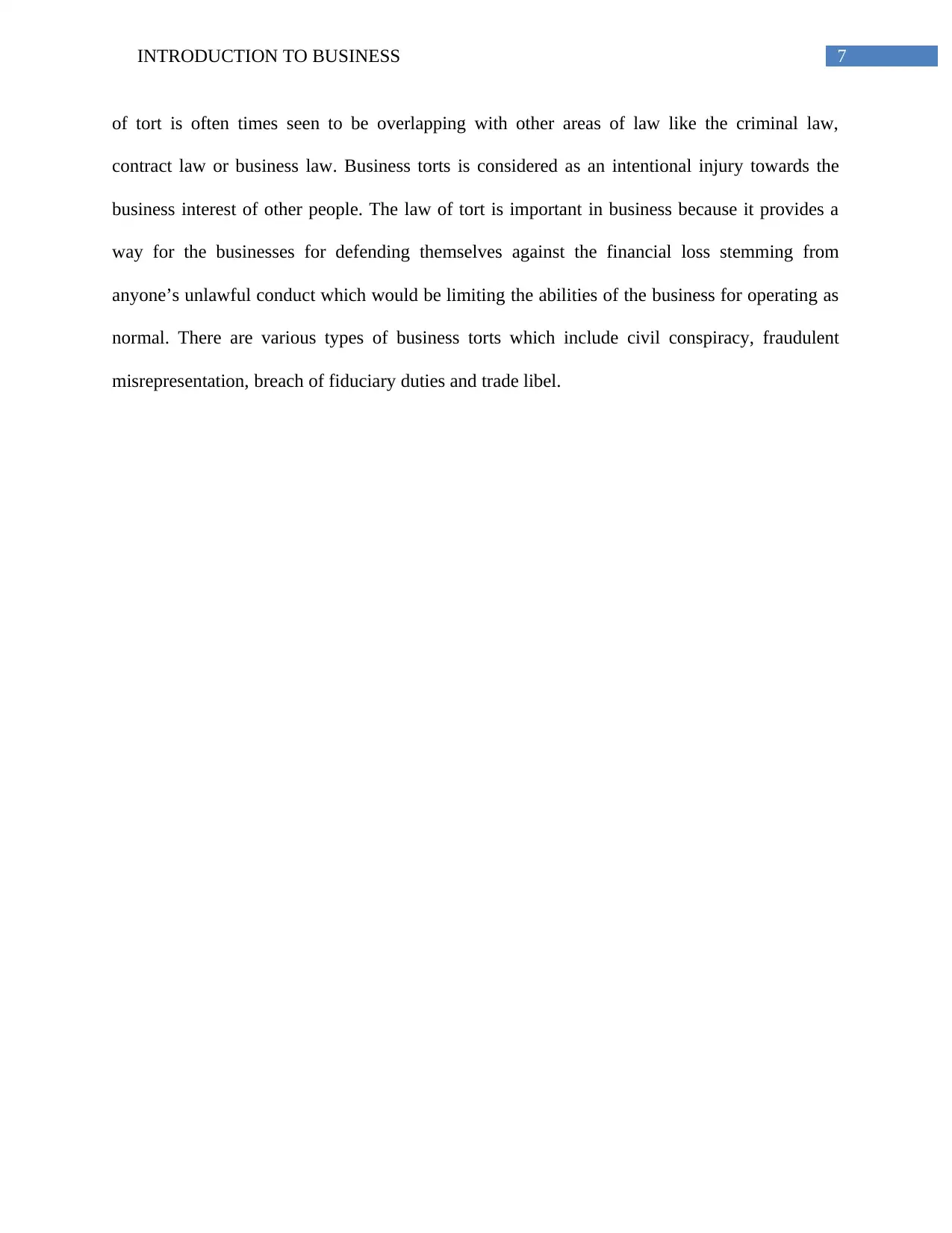
7INTRODUCTION TO BUSINESS
of tort is often times seen to be overlapping with other areas of law like the criminal law,
contract law or business law. Business torts is considered as an intentional injury towards the
business interest of other people. The law of tort is important in business because it provides a
way for the businesses for defending themselves against the financial loss stemming from
anyone’s unlawful conduct which would be limiting the abilities of the business for operating as
normal. There are various types of business torts which include civil conspiracy, fraudulent
misrepresentation, breach of fiduciary duties and trade libel.
of tort is often times seen to be overlapping with other areas of law like the criminal law,
contract law or business law. Business torts is considered as an intentional injury towards the
business interest of other people. The law of tort is important in business because it provides a
way for the businesses for defending themselves against the financial loss stemming from
anyone’s unlawful conduct which would be limiting the abilities of the business for operating as
normal. There are various types of business torts which include civil conspiracy, fraudulent
misrepresentation, breach of fiduciary duties and trade libel.
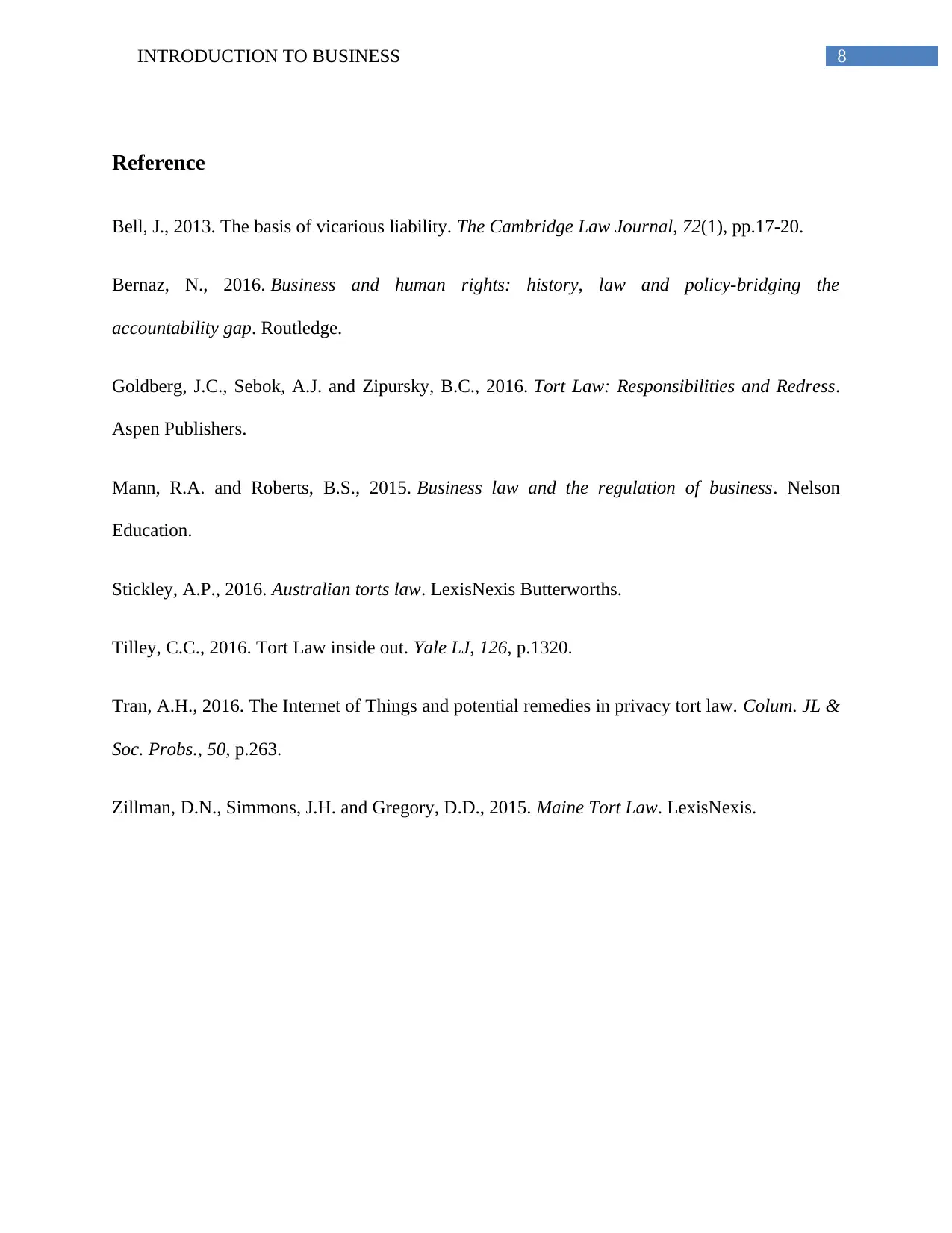
8INTRODUCTION TO BUSINESS
Reference
Bell, J., 2013. The basis of vicarious liability. The Cambridge Law Journal, 72(1), pp.17-20.
Bernaz, N., 2016. Business and human rights: history, law and policy-bridging the
accountability gap. Routledge.
Goldberg, J.C., Sebok, A.J. and Zipursky, B.C., 2016. Tort Law: Responsibilities and Redress.
Aspen Publishers.
Mann, R.A. and Roberts, B.S., 2015. Business law and the regulation of business. Nelson
Education.
Stickley, A.P., 2016. Australian torts law. LexisNexis Butterworths.
Tilley, C.C., 2016. Tort Law inside out. Yale LJ, 126, p.1320.
Tran, A.H., 2016. The Internet of Things and potential remedies in privacy tort law. Colum. JL &
Soc. Probs., 50, p.263.
Zillman, D.N., Simmons, J.H. and Gregory, D.D., 2015. Maine Tort Law. LexisNexis.
Reference
Bell, J., 2013. The basis of vicarious liability. The Cambridge Law Journal, 72(1), pp.17-20.
Bernaz, N., 2016. Business and human rights: history, law and policy-bridging the
accountability gap. Routledge.
Goldberg, J.C., Sebok, A.J. and Zipursky, B.C., 2016. Tort Law: Responsibilities and Redress.
Aspen Publishers.
Mann, R.A. and Roberts, B.S., 2015. Business law and the regulation of business. Nelson
Education.
Stickley, A.P., 2016. Australian torts law. LexisNexis Butterworths.
Tilley, C.C., 2016. Tort Law inside out. Yale LJ, 126, p.1320.
Tran, A.H., 2016. The Internet of Things and potential remedies in privacy tort law. Colum. JL &
Soc. Probs., 50, p.263.
Zillman, D.N., Simmons, J.H. and Gregory, D.D., 2015. Maine Tort Law. LexisNexis.
⊘ This is a preview!⊘
Do you want full access?
Subscribe today to unlock all pages.

Trusted by 1+ million students worldwide
1 out of 9
Related Documents
Your All-in-One AI-Powered Toolkit for Academic Success.
+13062052269
info@desklib.com
Available 24*7 on WhatsApp / Email
![[object Object]](/_next/static/media/star-bottom.7253800d.svg)
Unlock your academic potential
Copyright © 2020–2025 A2Z Services. All Rights Reserved. Developed and managed by ZUCOL.





